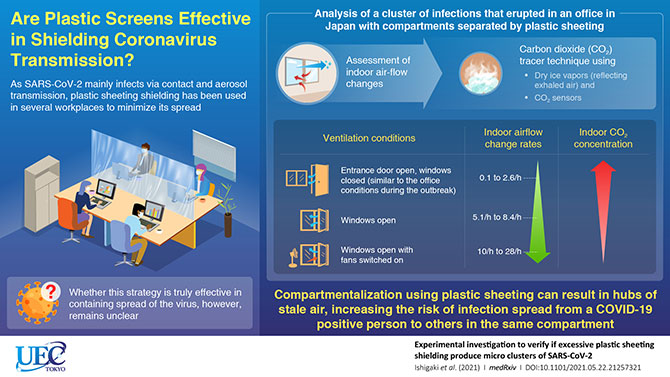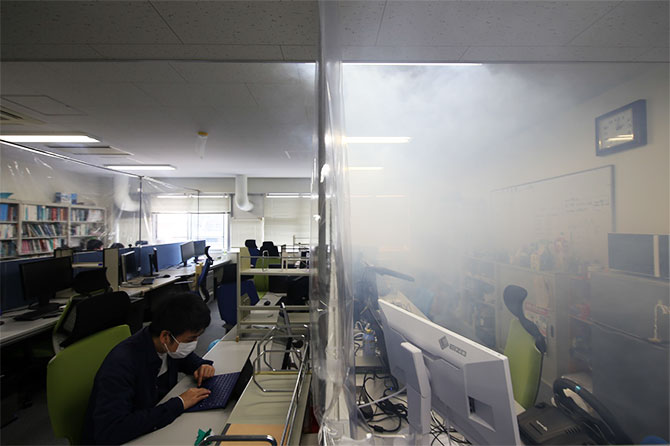2021.06.16
Compartmentalizing workspaces using plastic sheeting may block ventilation and hence increase the persistence of virus-containing aerosols in the room.
Many offices have attempted to protect their workers from the novel coronavirus by installing plastic sheeting dividers across workspaces to create isolation and distancing conditions. However, new findings by Japanese scientists who investigated an outbreakaffected office show that such compartmentalization can block ventilation for compartments, creating micro-hubs of virus-containing aerosols within them. Perhaps the practice of using plastic sheeting as a protective measure in shared indoor spaces needs a relook.
The COVID-19 pandemic has created an urgent need for measures to control the spread of the novel coronavirus. Given the importance of interpersonal contact as a means by which the virus is transmitted from person to person, lockdowns and the promotion of telecommunications over in-person meetings have been the lynchpins of most strategies for containing the pandemic. However, there are some areas of life in which people must gather together in indoor spaces. Given that the novel coronavirus can be transmitted via aerosols, it is vital that shared indoor spaces include systems designed to protect individuals from aerosolized virus particles.
For many shared office spaces, these systems take the form of plastic sheets used to divide the workspace into multiple small compartments. However, scientists have not yet conclusively determined whether compartmentalization based on plastic sheeting is an effective strategy for minimizing infection risks. While such compartmentalization can block the spread of aerosols from one compartment to another, it may also have the effect of raising aerosol concentrations within a compartment that an infected person has occupied, leading to greater infection risks for others who enter that compartment.
A team of Japanese scientists led by Associate Professor Yo Ishigaki of the University of Electro-communications (Tokyo, Japan) decided to clarify the effects of plastic sheeting on COVID-19 infection risk. "After there were clusters of unexplained outbreaks in an office in the Miyagi Prefecture, we decided to investigate what happened there," says Dr. Ishigaki. The outbreaks in question were two small clusters of infections occurring in March 2021 on an office floor where plastic sheets had been installed to divide the floor into five compartments.
The scientists investigated ventilation patterns within the various compartments by using carbon dioxide as a tracer chemical. This involved allowing a block of dry ice (i.e., solid carbon dioxide) to sublimate into gaseous carbon dioxide within different compartments and then measuring how compartment-specific carbon dioxide gas concentrations changed over time.
The scientists also used computer models of the office space to study how compartmentalization affected ventilation. Their results appear in a preprint article available on medRxiv.
The scientists observed extremely low air exchange rates in the compartments where infections had occurred. This meant that the aerosols released from an infected person could persist in the air for a long time. The office's only source of ventilation was a door, and the plastic sheeting probably hindered air exchange through the door. Computer modeling also showed that plastic sheeting blocked the flow of air within the office and trapped exhaled air within each compartment. When the scientists turned their attention to options for improving air flow within the office, they found that opening windows and using fans substantially increased the air change rates, meaning that exhaled aerosols could be more quickly removed from the office. Perhaps, adjusting the heights of the plastic sheets could have made a difference as well.
Their findings show that while plastic-sheeting-based compartmentalization schemes can be effective as protection, when poorly implemented, they can actually increase the risk of coronavirus transmission within indoor spaces. Balancing it with appropriate ventilation could be key to achieving protection. Dr. Ishigaki argues, "It is necessary to revise official guidelines concerning the design of compartmentalized indoor spaces. We hope our findings will encourage changes to guide people towards the proper installation of plastic sheets."


Public Relations Office
kouhou-k@office.uec.ac.jp